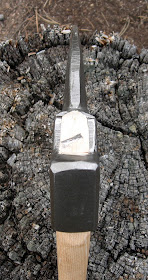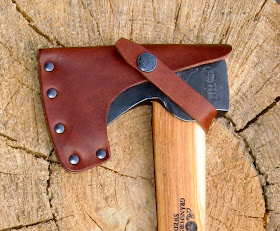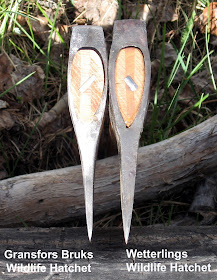Council Tool's new "Broad Hatchet" harkens back to the days of Colonial America, when talented craftsman built tall-masted sailing ships by hand, and determined settlers toiled to erect log cabin homes in the wild untamed American wilderness.
Broad
axes were an important tool in colonial times, useful for cutting
notches in logs as well as rough hewing beams for use in ships and log
cabins. Council decided to revive this classic axe design, which they
call the "Broad Hatchet", and which was also known as a Shipbuilder's
Axe or Carpenter's Axe in it's day. Council asked us to take a look at
the Broad Hatchet and post a review, so here goes......
Broad Hatchet SPECS:
Head Weight: 2.75 lbs
Overall Length: Listed as 28" on Council website, our review model measured in at roughly 27.25"
Handle type: American Hickory
Weight with sheath: 3 lbs, 13 oz (as measured on a digital postal scale)
Weight without sheath: 3 lbs, 10 oz (as measured on a digital postal scale)
Country of origin: Made in North Carolina, USA by Council Tool
Steel type: Drop Forged 1060 Tool Steel
Price: $59.95 (USD)
FEATURES
The Broad Hatchet as it came in the shipping box:
(click to enlarge)

The grain direction, grain quality and alignment on the handle are excellent:
The handle is hung with a traditional wooden wedge and metal pin, and is cut off flush with the top of the axe head.
The edge profile was not very well done. It was thick and uneven, and ended up requiring almost an hour of profile work on a belt sander (using a coarse grit) to get it to where it could be used properly. On a positive note, once the profile work was finished, the Broad Hatchet took a very sharp edge, and the steel seemed harder than most other Council axes I've used.
Another issue was the top of the handle close to where it joins the head. It was rough and unfinished to the point that several splinters peeled off the wood while handling it. The photo below wasn't quite able to capture the extent of this roughness, but you can see the area where a channel formed after a large splinter came out.
(click to enlarge)
The sheath that came with the Broad Hatchet is exceptionally well done. It's attractive, sturdy, and functional. I thought the Sam Browne studs, used in place of buttons to secure the straps, were a great idea.
FIELD TESTING
After the UPS driver dropped off the Broad Hatchet and I got my first
peek at it, I started having romantic notions of building my own log
cabin. I had never used an axe like this before, and the retro appeal
was undeniable.
(click to enlarge)
Sadly, the Broad Hatchet never made it through the first field test,
which was to chop a notch in a log, as though preparing it for log cabin
construction. On the third swing, the handle became noticeably loose,
to the point where I didn't feel safe using it anymore, and decided to
end the test.
The Broad Hatchet was received the night before the chopping test. It
should not have dried out in the few days it took to ship it from North
Carolina to Colorado, so I have to chalk it up to poor quality
control. I've also had loosening issues with three Standard Council
Tool Hudson Bay axes and a Council Jersey Axe in the past couple of
years, where the handles loosened within days or weeks after receiving
them, so I can't say this is something new I've seen from Council. Maybe
they are over-drying the handles prior to assembly? It's hard to say,
but hopefully they will take note of this issue and address it soon.
Conclusion
Though the Broad Hatchet has undeniable retro appeal and a really spiffy sheath, there are just too many quality control issues to give it my recommendation. For the $60.00 asking price, I think Council could do better.
2 out of 5 Stars (Not Recommended)
For more info, visit www.counciltool.com/product.asp?pg=product&item=275BRD28C
For more info, visit www.counciltool.com/product.asp?pg=product&item=275BRD28C
About the author
 Jason Schwartz is the founder and senior editor of Rocky Mountain Bushcraft. He is a former Red Cross certified Wilderness & Remote First Aid Instructor, and has taught bushcraft and wilderness survival techniques to the Boy Scouts of America, interned with the US Forest Service, and studied wilderness survival, forestry and wildland firefighting at Colorado Mountain College in Leadville, Colorado. Jason has also written for magazines such as The New Pioneer and Backpacker, including writing the "Tinder Finder" portion of Backpacker's "Complete Guide to Fire," which won a 2015 National Magazine Award (NMA). Email him at rockymountainbushcraft @ hotmail.com (without spaces)
Jason Schwartz is the founder and senior editor of Rocky Mountain Bushcraft. He is a former Red Cross certified Wilderness & Remote First Aid Instructor, and has taught bushcraft and wilderness survival techniques to the Boy Scouts of America, interned with the US Forest Service, and studied wilderness survival, forestry and wildland firefighting at Colorado Mountain College in Leadville, Colorado. Jason has also written for magazines such as The New Pioneer and Backpacker, including writing the "Tinder Finder" portion of Backpacker's "Complete Guide to Fire," which won a 2015 National Magazine Award (NMA). Email him at rockymountainbushcraft @ hotmail.com (without spaces)

































































